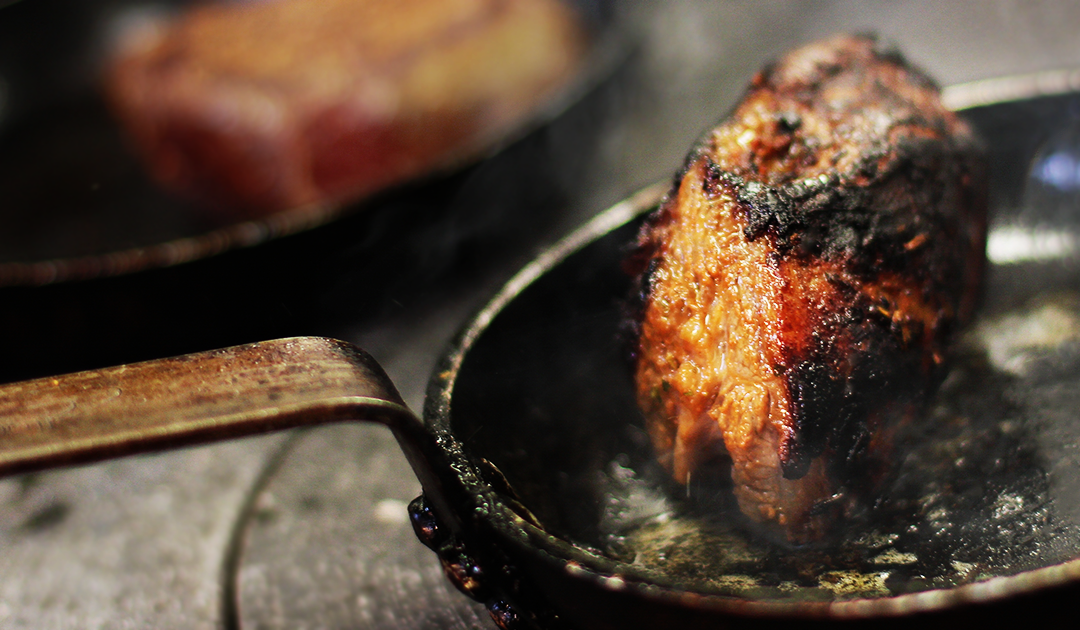In the spirit of being located in Carmel, IN, here’s a guide to searing and CARMELizing your meats!
Why is searing your meat before roasting or grilling so important? It’s about sealing the inside meat so that it remains juicy and tender. Sealing in the juices cause them to end up in your stomach instead of on your plate, making for a more flavorful meal! The taste of seared meat adds a crust or flavorful caramelization to the protein—this is that restaurant–quality taste that we are often missing at home. Slightly sweet and slightly crunchy, the natural sugars in the protein form a crust that is simply delicious.
So, crank up that grill for 5 minutes beforehand or heat up that cast iron pan and go for it, right? Not so quick dear customer! Here are a few tips to make sure you nail a perfect crust/caramelization each and every time you roast or grill your protein.
- Take the chill off your meat by pulling it out of the fridge to set out at room temperature. Doing this allows the protein to relax and the moisture to reabsorb in the muscle, rather than being trapped between the protein fibers. How long to leave it sitting out at room temperature is often a matter of debate, but we recommend at least an hour and even longer on larger cuts. Be sure to dy off any excess moisture with a paper towel before searing.
- Season away! Kosher Salt is key here, as the salt sticks to the moist surface of the protein to form a flavorful crust. Be liberal, but not excessive with the salt. If your meat has been marinated or brined, don’t salt it. Instead, pat the protein dry to remove extra marinade before searing.
- Heat your pan first! Make sure your searing pan is hot, hot, hot. If your pan is too cool, the protein will stick and tear when you try to turn it. If you’re grilling, make sure your grates are oiled with veggie oil (use a folded paper towel to wipe it on before turning on your grill) and then turn all your burners to high and let it heat up to 500 degrees or higher.
- Let’s add some fat to the pan. If you are pan searing a lean cut (pork tenderloin, chops, chicken or lean beef), add about two tablespoons of veggie oil to your pan. Don’t use olive oil or butter—both have too low a smoke point. When the oil ripples, add the meat. If you are doing cubes, such as filet tips, don’t crowd your pan, otherwise the meat will steam instead of sear. Sear them off in batches instead.
- Sear it well! Place your protein in the pan fatty side down or skin side down. Hot oil may spatter and spit so take care! Don’t move the meat and instead, let it sear undisturbed for a few minutes—longer for roasts, shorter for steaks or tips—and then flip it over. If your pan was hot enough and your meat seared long enough, it should lift without tearing. Sear the other side the same way. If you have a roast, sear the ends as well—you may need to hold a roast with tongs for this part. For grills, we recommend only 1 to 2 minutes per side of your protein with the lid closed. If you have a big roast, you may need to use long tongs to sear the ends while the grill lid is open.
- Now that the meat is seared and wonderfully browned, finish it by roasting it in the oven, simmering on the stove or adding it to your slow cooker. There are a variety of opinions here when it comes to doneness and we suggest using a meat thermometer to ensure your protein has reached the desired doneness. For a grill, turn one half of the grill off and the other side to medium low and cook your meat the rest of the way on the “off” side (in effect, you are creating an oven). Leave the lid open for three minutes or so after searing so that the temperature drops on the grill.
- Don’t waste the pan juices! The crusty bits and oil left in the pan are called “fond.” You can make a delicious pan sauce from this by deglazing the pan with a small amount of liquid. We are not covering how to make a pan sauce here, but look it up online, it’s easy and quick.
- Let it rest! For any roast or steak from an oven, it’s incredibly important to let your meat rest before carving. Cuts of meat are still expanding when you take them from the oven, so carving your protein right after it exits the oven will leave you with a plate of juice and a piece of protein that is dry and looks overdone. Resting recommendations vary by the size of protein, but a good rule of thumb is at least 12 minutes for a chicken breast, steak or pork tenderloin, and up to 25 minutes for a roast.
Happy CARMELizing to all of you!

